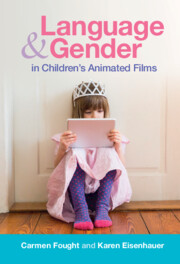Book contents
- Language and Gender in Children’s Animated Films
- Language and Gender in Children’s Animated Films
- Copyright page
- Dedication
- Contents
- Figures
- Tables
- Preface
- Acknowledgments
- 1 Introduction
- 2 Gender, Disney, and Pixar in Historical Context
- 3 Representation, Speech Amounts, and Talkativeness
- 4 Compliments
- 5 Directives
- 6 Insults
- 7 Apologies
- 8 Representing Queerness
- 9 Conclusion
- References and Filmography
- Index
2 - Gender, Disney, and Pixar in Historical Context
Published online by Cambridge University Press: 01 September 2022
- Language and Gender in Children’s Animated Films
- Language and Gender in Children’s Animated Films
- Copyright page
- Dedication
- Contents
- Figures
- Tables
- Preface
- Acknowledgments
- 1 Introduction
- 2 Gender, Disney, and Pixar in Historical Context
- 3 Representation, Speech Amounts, and Talkativeness
- 4 Compliments
- 5 Directives
- 6 Insults
- 7 Apologies
- 8 Representing Queerness
- 9 Conclusion
- References and Filmography
- Index
Summary
This chapter provides a historical context for Disney and Pixar, and delineates how the two studios have evolved to respond in different ways when it comes to the politics of media representation. The Classic Era of Disney (1937-1959) features a conservative vision of the ideal female character, princesses who are polite, kind, white, and traditionally beautiful. The Renaissance Era of Disney(1989-1997) buoyed by the second and third waves of feminism began to present more “empowered” heroines, who aimed to embody (or at least acknowledge) the values of feminism, and some diversity in terms of look, even if the actors and speech remain primarily white. The New Age Era of Disney (2009-2019) is ongoing, and features more diverse princesses both in terms of look and in terms of subverting more traditional princess tropes (Frozen) or doing away with romance altogether (Brave and Moana). Pixar does not have eras in the same way as the Disney films, because it is less less focused on female leads and thus less influenced by feminist discourse . However, Pixar is important in terms of examining masculinity in children’s films, and how language and gender compares to the Disney canon.
Keywords
- Type
- Chapter
- Information
- Language and Gender in Children's Animated FilmsExploring Disney and Pixar, pp. 21 - 43Publisher: Cambridge University PressPrint publication year: 2022



